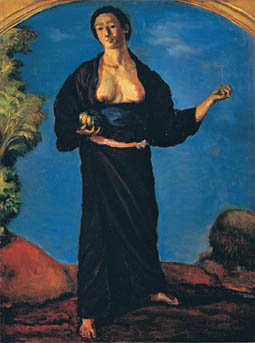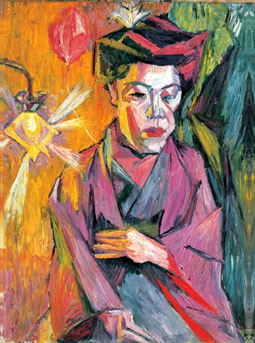 |
|
 |
| Ryusei Kishida, "Girl with Squash" (1914) |
|
Tetsugoro Yorozu, "Woman with a Balloon" (1912-13) |
|
|
The nationwide touring exhibition "Expressionist Movements in Japan," presently at the Hyogo Prefectural Museum of Art, is an early 21st century riposte to the lingering idea that after the introduction of Western art forms at the end of the Edo period (1603-1867), Japanese art was simply derivative of European sources. The central claim is that Japanese artists of the late 19th and early 20th centuries were not blindly following Western precedents as had painters working in realism in the late Meiji period (1868-1912), which the exhibition catalogue labels a "blank period." Rather, expressionism is posited as emerging independently, at least in part, from within Japan's own mix of transplanted and domestic art movements.
Expressionism has normally been understood to gather momentum in Japan around the years 1910-12, but the present exhibition pushes this back twenty years or so in an introductory section called "Prefigurings." The kernel of expressionism can be intuited in the romantic sentiments of poet Tokoku Kitamura (1868-94) in his "Theory of Inner Life" (1893), where he noted that for the Japanese to become a modern people, "they must recreate their own visual perception and possess 'the inner-sight of life.'" Then, in the paintings of Seiki Kuroda (1866-1924), a heightened attention to color, deformation of subjects and emphasis on surface texture can be observed in works like "Oiso Shigitatsuan (Haiku Dojo)" (1896), contrasting with the plein-air Impressionism he is conventionally known for. Expressionist aims continue to appear in much later works, as in the abstract and loose brushwork of foliage in disarray in Kuroda's "Storm" (1919).
Other early signs of the independent emergence of expressionism are located in the literary journal Myojo, launched in 1900, which declared that the basis for newness was to be found within the artist's subjectivity. Leading painters such as Takeji Fujishima (1867-1943) were recruited to design the covers, and in one, the "Cover for the Year of the Horse Edition, No.1" (1906), can be discerned traces of not only Art Nouveau but also a more broadly expressive approach. These "prefigurings" are in many ways a jumbling of East and West, but the situation was much as the architect Keiji Goto (1883-1919) later announced: "the only solution is to find an internal law; one must digest all external objects and establish a totally new autonomic law within oneself." While the voluminous evidence rounded up here tends to suggest that these writers, artists and architects were indeed deviating from Western constructions of modernism, it must also be noted that these figures are also being retroactively ascribed expressionist tendencies they did not necessarily subscribe to themselves.
Further clear manifestations of expressionist allegiances emerge after the establishment of the Bunten (Ministry of Education Exhibition) in 1907, which quickly became positioned as an exhibiting institution for artistic orthodoxy. Artists with more avant-garde proclivities set up alternative venues such as the Fyuzain-kai in 1912, which included Tetsugoro Yorozu (1885-1927), perhaps the most representative Japanese expressionist painter of his age. Yorozu's early work followed after painters like Matisse and Van Gogh; in a curious reversal, since expressionism is usually understood for its deformation of the human subject, Yorozu's depictions of women were praised by contemporary critics for the correct proportions of the sitter in contrast to the idealized bodies of earlier realist movements. A few years later, Yorozu would turn to nanga ("Southern School painting," originally an import from China), having found in it a faithful Eastern equivalent of expressionism that did not require recourse to European artists and movements, as in "Landscape with Wagon" (1922).
In architecture, too, dissent from European precedents was emerging by 1910 in debate on the question "What should our country's style of architecture be?" which generated a shared aim of seceding from European styles. This precedent was again taken up by the Bunriha group of architects, founded in 1920, who declared architecture to have both practical and expressive artistic functions that were occasionally yoked to spiritual themes, as in Sutemi Horiguchi's (1895-1984) elevation view design for "First Tentative Proposal for Core Architecture to Assemble People for the Coming Spiritual Civilization" (1920).
Indeed, aspects of expressionism were emergent not merely in painting and architecture but in all the arts, from the feminism of Japan's first all-women literary magazine Seito (Bluestocking) to costume and set designs at the Tsukiji Shogekijo theater. Sculpture and crafts developed more conservatively, circumscribed as they were by tradition and functionality, though it was in this period that craftsmen came to establish themselves as independent creative artists.
It is apparent, then, that the notion of Japanese expressionist art as constituting a minor wake to avant-garde European movements has come under considerable critical attention and revaluation in recent years. So too has the idea of a one-way transmission from West to East that posits Japanese modernism as the lesser and uninspired heir to European originators. This assertive and timely exhibition calls for additional examination of the distinctive artistic achievements of Japan's Taisho period and beyond.
|